Discuss Notion Music Composition Software here.
6 posts
Page 1 of 1
|
This is an older recording from my catalog, I released the first movement previously in the Works Series (19-3). I've improved my craft since, but it's good to look back and I'd rather release these recordings than let them languish on a hard drive. This recording from 2019, recorded with Spitfire Chamber Strings and Berlin Strings First Chairs. I will release the third movement later this year. My intent was to release an album of a number of Twentieth Century Serenades and Suites for Strings of which Elgar's Op. 20 would be one selection.
I'm sharing this here with the Notion community prior to general release. Enjoy, and feedback is always appreciated! phpBB [audio]
iMac (Retina 5K 27", 2019) 3.6 ghz I9 8-core 64 gb RAM Fusion Drive
with small AOC monitor for additional display macOS Sonoma 14.4 2 - 500 gb + 2 - 1 tb external SSD for sample libraries M Audio AirHub audio interface Nektar Panorama P1 control surface Nektar Impact 49-key MIDI keyboard Focal CMS40 near-field monitors JBL LSR310S subwoofer Notion 6/Notion Mobile + Studio One 6 Pro http://www.tensivity.com |
|
This is good, and I like the strings, but it's not a headhone mix . . .
THOUGHTS At present I am doing everything when listening with studio-quality headphones like SONY MDR-7506 headphones (a personal favorite), which is the result of one of the Kustom PA loudspeaker units exploding and bursting into flames after a lightning strike about a year or two ago . . . I have a replacement unit, but I'm lazy and have not installed it yet . . . When I listen with studio-quality headphones, nearly everything appears at far-left or thereabout, which might be correct placement when the goal is to sound like a real orchestra; but for headphone listening it's not balanced . . . SUGGESTION: If you have not listened to the mix played through studio-quality headphones, then this is my advice: Listen to the mix played through headphones or ear buds . . . With loudspeakers, everything tends to be more balanced; but this is not the case with headphone mixes unless you mix it specifically for headphones . . . Whether this is good, bad, or indifferent is another matter, but when I listen to this mix with headphones, I want to adjust the balance or to make it monaural so that it's not all on the left side . . . ASSORTED OCD RAMBLING DETAILING THE HISTORY OF MUSIC PLAYBACK DEVICES AND RADIOS IN THE 20TH CENTURY, MOSTLY DUE TO CONSUMING HUGE QUANTITIES OF VERY STRONG COFFEE I'm installing and upgrading digital music production software on the Mac Pro (Mid 2010), and when doing this I tend to consume huge quantities of very strong coffee . . . When my studio monitor system is working, I first do a loudspeaker mix and then follow-up with a headphone mix, mostly making only subtle changes in the headphone mix, followed by verifying that it sounds good when played through loudspeakers, which is an iterative process . . . Ideally, it should sound good both ways, although I think that at the dawn of the early 21st century most folks listen to music either (a) in their vehicles played through what typically are somewhat audiophile quality systems tailored to the specific vehicle or (b) played through headphones, ear pods, and other in-ear devices . . . Most folks have vehicles--unless they live in a large city where other forms of transportation make more sense--and most folks have iPhones, ear buds, and so forth . . . If you are in the audience sitting in the sweet spot in the middle, then violins should be on the left; but when you are listening with headphones and ear buds, having everything mostly on the left is not so good . . . George Martin and Capitol Records tried something similar with a few early Beatles songs, but it was odd to have the instruments on the left and the singing on the right . . . [NOTE: In the early-1960s, the "stereo" versions were odd and mostly were considered to be "European" or something. I knew a few folks who had the "stereo" versions on vinyl, but these versions mostly were novelties and perhaps were useful only for identifying vocal harmonies. It was the Beatles, but splitting the instruments and vocals was confusing and arbitrary . . . ] [NOTE: This is the monaural version, which was the version most folks heard. When listening with headphones, everything (instruments and singing) is a top-center, so it takes a while to become accustomed to it, but at least it's balanced . . . ] They did it this way because stereo at the time was new; and "stereo" mixes were done after fact arbitrarily using monaural tracks, since at the time there were no stereo mixes or stereo anything, due to using two-track or three-track magnetic tape recorders . . . This changed later as the technology advanced; and George Martin developed a strategy for doing what I call "Beatles-style headphone mixes", even though nearly nobody other than musicians and recording studios had headphones . . . George Martin and the audio engineers at Abbey Road Studios used one track for the instruments and another track for the singing; and they devised a strategy for doing overdubs, but when mixing they first did the monaural mix, because it was what was played on AM radio stations and all the other, at the time, ubiquitous media, including jukeboxes and vehicle radios, which had vacuum tubes and were monaural, although transistor AM radios where appearing, but portable transistor radios where monaural . . . As I recall, there were no FM radio stations (or if there were, then there were no portable FM radios) . . . It was not until later in the mid-1970s or thereabout that headphones started to become ubiquitous, but even then they were not something most folks had . . . Today at the dawn of the early-21st century, I think it has shifted the other way, where headphones and ear buds are ubiquitous, along with audiophile-quality vehicle sound systems . . . I suppose the other ubiquitous media is YouTube where songs are played through tiny loudspeakers in the iMac or similar computing device, with the tiniest loudspeakers in MacBooks being the worst . . . Lots of FUN! P. S. Rollback the sound isolation studio clock 10 or 20 years, and I was doing headphone mixes that ranged in overall quality from bad to terrible; but after getting some advice from Magic Dave at MOTU, which mostly was that it made little practical sense to have a separate microphone for every drum, cymbal, and Latin percussion instrument in a studio that is 6 feet wide by 7 feet high and 12 feet long, which was made all worse by connecting the microphones to two physical mixers and then running that set of output signals to a third mixer, which ultimately was connected to a MOTU 828mk!! external digital audio and MIDI interface . . . Other than not doing what I was doing, the advice from Magic Dave was to connect two microphones directly to the MOTU 828mkII, a strategy that guaranteed strong, clean microphone signals . . . However, the key bit of advice from Magic Dave regarded my question about being able play all the parts to most early-Beatles songs but the instruments never sounding exactly like the instruments on Beatles' records . . . The specific advice (paraphrasing), is that anybody with at least some musical talent and playing ability can sound like the Beatles if they practice each song and each of its various parts 1,000 or more times, practicing the song over and over until it's perfect . . . Explained another way, if you expect to be good at golfing, then play golf every day . . . This was a big step in the right direction, but it didn't solve all the various problems until I realized the vast importance of having a calibrated, full-range studio monitor system with a flat equal loudness curve running from 20-Hz to 20,000-Hz (the full-range of normal human hearing) . . . That's the way I mixed for several years, mostly until one of the Kustom PA loudspeakers exploded and burst into flames after a nearby lightning strike and power surge which the Tripp-Lite surge protectors did not handle, although they protected everything else, including the Mac Pro (Early 2008) . . . Since then, I have been doing headphone mixes, which works because I learned how everything behaves when listening with studio-quality headphones and doing the audio work in Studio One Professional . . . I need to install the replacement Kustom PA loudspeaker unit, which is on my list of things to do . . . This is an elaborate way to suggest that you have the mix done while listening to your studio monitor system;; so listen to the mix played through headphones and make some mostly subtle adjustments to balance the way the instruments are panned, while allowing the usual orchestral positioning and imaging; and then check it by playing the mix through your studio monitor system, which is fabulous . . . Fabulous!
Surf.Whammy's YouTube Channel
The Surf Whammys Sinkhorn's Dilemma: Every paradox has at least one non-trivial solution! |
|
Surf, thanks for listening and your detailed commentary as always! I always mix in headphones, using my faithful Sennheiser SD600 open back studio headphones, which I highly recommend for classical work. There are times when I find the sound so realistic and the headphones so comfortable that I sometimes forget I'm listening to a headphone signal and not through monitors. Because my work involves repeated listening many times over of the same passage or piece, I primarily use headphones in my work to prevent driving my wife crazy. I use monitors less frequently to check a mix and for the essential task of checking reverb settings.
I think what you're hearing mostly (and I'll expand on that later) is due to a combination of the composition itself and the seating arrangement of string orchestras. Composition: The Serenade for Strings in E minor, Op. 20, is a piece for string orchestra in three short movements, by Edward Elgar. It was written in March 1892 and first performed in private in that year, by the Worcester Ladies' Orchestral Class, with the composer conducting. It received its first public performance in Antwerp, Belgium on 21 July 1896. My recording of this composition as posted is one of three recordings in the series of movements. I posted the first movement last year which can be listened to here: phpBB [audio] I might choose to release these as part of an album or EP later. Because I want to make sure that my series of recordings are all three consistent in sound quality, I'm locked in to certain decisions artistically and production-wise. It's not the same situation as when George Martin was making decisions about panning and placement in the stereo field of where certain instruments appear in one three-minute song and then moved on to the next. In order to avoid having it sound like all my musicians played a game of reverse musical chairs between each movement where after the music stopped they grabbed their instruments, jumped up, ran around the stage, and reseated themselves (which might be amusing but not particularly effective in presenting a musical composition of three related movements) I need to be consistent in the series of three recordings and part of my goal is to try to replicate a real orchestra, which brings me to Orchestral Seating: Since the 30's most string orchestras follow the Stokowski arrangement when seating themselves (though in Europe a different seating layout is often used). This arrangement standardized by Leopold Stokowski in his radio recording/broadcasting sessions for NBC was to arrange the strings based on frequency of the instruments, with violins being placed stage left and cellos and basses being placed stage right.This was convenient for Stokowski in addressing the different sections of the orchestra, and since there was no such thing as stereo then it was easy for the engineers recording the works, but it's by no means logical in terms of balance for stereo placement of the range of the orchestra. This is certainly not a fixed standard and I've played with different arrangements but this is the arrangement I chose to emulate with these recordings. Because of the natural acoustics of concert halls where string orchestras play it's not an issue when orchestras seat themselves this way for a live presentation because the early reflections of the room and the natural reverb works to blend the different instruments together into a cohesive organic sound for the listener, and if they closed their eyes and didn't see the instrumentalists they would be hard pressed to know specifically where one instrument or section was located. SO now we get to why you're hearing something that seems off-balance to you: What you're hearing is a combination of the composer's (Elgar's) decision to highlight the high strings (violins) in this movement along with the conductor's (Myers') decision to seat the orchestra based on the Stokowski layout. The melody line is strongly highlighted in the composition of this movement with the high frequency violins (the ones on the left of the stage) being to the fore. So the result is that you hear something that to you seems out of balance but to me relates to a very logical and natural arrangement of the musicians on the stage and the composer's intent. Now, to be fair, after some critical listening based on your comments, I think that I might have been a little heavy handed with this mix, with the violins mixed a bit heavy in balance to the other instruments in order to highlight the melody in this movement. I'm going to take a look at that and will take another cut at the mix. So, very helpful feedback, and its all fabulous! By the way, in relation to the history of stereo mixing, occasionally when I listen in headphones I come across what to me are some real oddities in recordings from the early days of 4-track and stereo where engineers were taking mono tracks and placing them in the stereo field arbitrarily. Gerry and the Pacemakers' Ferry Cross the Mersey is a good example. The guitar and percussion is all crammed into the right channel, and the orchestra is all stuck into the left, with the result being that they sound as if they were in different boxes. Even George Martin was guilty of this on some Beatles work. In Eleanor Rigby Paul's voice bounces around the stereo field throughout the song, and every time I hear it I always picture Paul in my mind running from one mic to another across the stage as he sang!
iMac (Retina 5K 27", 2019) 3.6 ghz I9 8-core 64 gb RAM Fusion Drive
with small AOC monitor for additional display macOS Sonoma 14.4 2 - 500 gb + 2 - 1 tb external SSD for sample libraries M Audio AirHub audio interface Nektar Panorama P1 control surface Nektar Impact 49-key MIDI keyboard Focal CMS40 near-field monitors JBL LSR310S subwoofer Notion 6/Notion Mobile + Studio One 6 Pro http://www.tensivity.com |
|
It's good to have a positioning strategy, and I think you have one that makes sense . . .
THOUGHTS In the postscript to my previous reply, I was going to segue into an observation about positioning, but I was distracted by recalling the advice from Magic Dave at MOTU, which was very helpful advice . . . After I wrote the postscript, I was wondering what the point was; but it was relevant in one way or another and by that time I had forgotten the original purpose of the postscript . . . When I first started doing music again, which was about 15 to 20 years ago, I mixed based on what sounded good to me at the time; but there was no obvious panning and positioning strategy . . . After a few years, I started wondering what the strategy actually was; and I started focusing on determining what the listening perspective might be . . . Was it the way it sounded to the musicians on stage? Or was it the way it sounded to a listener in the audience sitting in front of the stage in the "sweet spot" in the middle perhaps 10 to 20 rows away from the stage? Then I started pondering how someone listening to the mix would perceive it? At one point, I think I considered how the music might sound to the drummer who was in back of the musical group, which typically in days before stage monitors and in-ear monitoring was distinctly different from what the other musicians, singers,and audience heard . . . It soon wandered into deciding on what might be the best frame of reference, if there was a "best" frame of reference; and this led for a while to considering binaural listening where the strategy is to have a microphone placed near each ear, so that what is recorded is a near as possible to what a person hears . . . Wave Arts has a panoramic effects plug-in that is intriguing, and I experimented with it for a while . . . 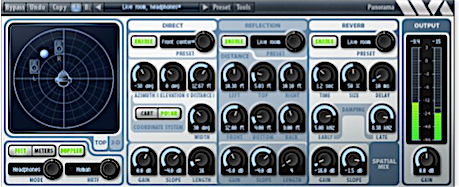 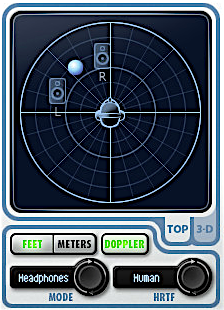 Panorama 6 (Wave Arts) You specify the location or position of the signal (instrument, voice, or something like a helicopter, train, or some type of moving machine) by changing the location of the tiny sphere, and there are different coordinate systems . . . In theory, if you move the tiny sphere atop the head icon, then the sound appears to be overhead . . . The position of the tiny sphere can be automated, which makes it possible to do fly-bys and things like the sound of someone walking across a room . . . It's a science-based effects plug-in, and in some scenarios it's very realistic . . . The science aspect is that the algorithm is designed to provide location and position cues, but for the most part they are subtle and work best when there are not a lot of other sounds, music, and so forth, which especially is the case for overhead locations, back locations, and front locations . . . Left and right are easier, but front, back, and overhead are complex; and underneath is nearly unattainable . . . I experimented with it in songs, but the other instruments and singing tended to overwhelm the audio cues that the perceptual apparatus of the mind needs for accurate front, back, and overhead positioning . . . It's a "heavy" effects plug-in, and it uses a lot or system memory and processor cycles; so after a while I stopped using it in songs . . . As I define it, the rules work best when there is one sound being moved around, like a person walking across a room or a person talking and walking across a room, which works until you add a lot of instruments and singing; so from my perspective it's a bit like a foley soundstage used to add sounds to motion picture soundtracks . . . Over time, I started focusing on the way hit songs are mixed; and there are a few basic rules, one of which is that most of the drumkit (nearly always the kick drum and snare drum rimshots, unless there are dual kick drums and dual snare drum rimshots and you want to introduce motion where one is far-left and alternates with the one at far-right), and bass tend to be top-center (headphones) or middle (stereo studio monitors) . . . [NOTE: This is the definitive positioning for kick drum, snare drum rimshots, hi-hats, and synthesized bass. It's also excellent for centering "middle" of a stereo studio monitor system; and it's one of the songs I study . . . ] [NOTE: Occasionally, I have three kick drums and three snare drums positioned {far-left, top-center, far-right}. I usually have two Audio Tracks for rhythm guitars {far-left. far-right} but put more emphasis on the far-right rhythm guitar to position it more to the right . . . ] Singing also tends to be this same placement, as are lead guitar solos . . . There are variations, of course, and one of them moves the singing to far-left and far-right but with mostly subtle delays, since the same signal (instrument or voice) on two tracks, one panned far-left and one panned far-right, maps to top-center or middle . . . The best example of this is "Who Owns My Heart" (Miley Cyrus) which was produced by Rock Mafia . . . [NOTE: Every song I post is best enjoyed and understood when listening with studio-quality headphones--my original songs and songs by other folks, like the songs by Michael Jackson, Miley Cyrus, and Jerry Lee Lewis in this post . . . ] When the song starts, Miley's singing is top-center with syrupy echoes . . . This is standard "goto" positioning for the lead singer, and the echoes wander from side to side to provide a sense of motion . . . Explained another way, Elvis is always top-center (headphones), and it's the standard position for the lead singer, but there are variations and exceptions . . . The perspective changes for the chorus at 0:58, and then Miley's singing is panned far-left and far-right but with subtle delays that reinforce the far-left and far-right locations, where it's a combination of subtle delays (different for each side) and overdubs, which essentially also are subtle delays . . . Then at 1:30 it returns to the standard, top-center (headphones) location, and so forth . . . At 1:59. it's back to the split (far-left and far-right with subtle delays and overdubs) . . . Then at 2:27 it's back to the standard, top-center (headphones) location, during which Miley Cyrus proves that she actually can sing . . . And at 2:55 it's back to the split (far-left, far-right, with delays and overdubs) . . . This is one of the songs I study, and my best guess so far is that including the virtual festival of backup singing, there are 100 to 150 vocal tracks when one counts custom and syrupy echoes and individual overdubs of the beginning and endings of words . . . If you focus on the synthesizers, you discover that they become more prominent after the split and then become less prominent during the next split, which is simply brilliant producing and audio engineering . . . [NOTE: The far-left and far-right split also has a subtle top-center component, so it's more complex that one might imagine . . . ] The first record I bought was "Great Balls Of Fire" (Jerry Lee Lewis), and the primary reason was the slapback and syrupy echoes . . . It was a 78 RPM record with one song on each side, and it was monaural . . . Here in the sound isolation studio, it's more important to be surreal than real, at least most of the time . . . When you get the audio into Studio One Professional, it becomes possible to duplicate Audio Tracks, so that you have two identical copies which than can be split by a tiny amount to create a larger space . . . Reverberation units do this, as do certainly types of echoes; but having identical copies and then moving one of them a tiny bit forward in the timeline creates another effect which is a variation of the Haas Effect, although this can be done with a simple digital delay, if you can find one . . . Basically, you want to have the identical sound arriving 5 to 25 or even 50 milliseconds after the first of the two identical sounds . . . At 25 milliseconds of delay for one of the Audio Tracks, it's more subtle . . . At 50 milliseconds it starts to become obvious, and at 75 milliseconds it becomes fast slapback echo . . . Reason (Reason Studios) has a third-party digital delay that is simple, but until recently it's the only one I have found . . . More recently, I determined that McDSP has reverberation and echo effects plug-ins that can be used as simple digital delay units, which is excellent . . . It has three types of echo units (magnetic, digital, and analog); and the digital echo unit is the one which can be configured as a simple digital delay, where "simple" in this context maps to repeating the input one time with no extra processing, added reverberation, or echoes . . . This is important, because with simple delay set to very short values, you can add the Haas Effect to selected Audio Tracks in Studio One Professional . . . [NOTE: Panning works by controlling the respective left and right volume levels, except that a true panning control is monaural and literally moves the monaural sound across the Rainbow Panning Arc, as I call it. With few exceptions, most stereo panning controls actually are balance controls and as such are not true panning controls. Balance controls simply increase or decrease the sonic content of each channel (left, right) and are not panning controls. Curiously, in the sense that there is no specific explanation for their behaviors in the user guide, the panning controls in NOTION are nearly perfect, true panning controls rather than balance controls, which explains the more elaborate way they behave. The Haas Effect does it's sonic magic by controlling time, irrespective of volume (more or less for practical purposes), where the rule for the Haas Effect is that it requires two identical sounds, which in turn maps to identical volume levels . . . ] 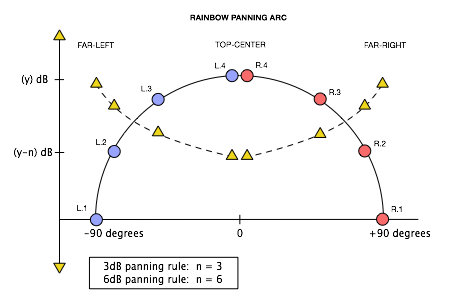 EC-300 Echo Collection (McDSP) In the real world, there is one orchestra and it's located in front of the audience; but in the surreal world you can have several orchestra located all over the place; and if desired, the orchestras can be put in motion, as well . . . Lots of FUN! P. S. These images provide a few clues, where "A" is anterior and "P" is posterior, while "T" is top and "B" is bottom. "L" is left, and "R" is right, which is fabulous . . . 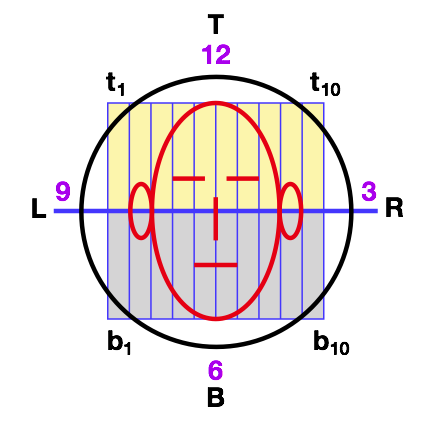 Inside the mind ~ Looking outward 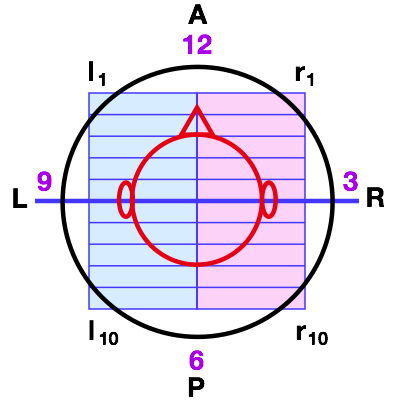 In a mini-helicopter hovering over your head ~ Looking downward 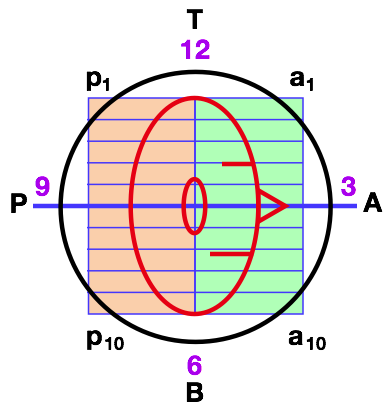 View from the right side 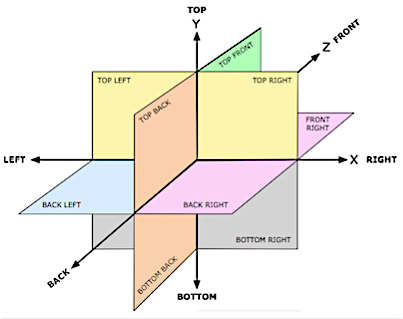 3D Perspective Fabulous!
Last edited by Surf.Whammy on Mon May 24, 2021 12:33 am, edited 4 times in total.
Surf.Whammy's YouTube Channel
The Surf Whammys Sinkhorn's Dilemma: Every paradox has at least one non-trivial solution! |
|
I've remixed and remastered and the new version is posted at the same link as the original. Thanks for your critical listening, SurfWhammy! It was very heavy handed in the original mix with the Violins being mixed too loud. I think it's a much more balanced and pleasant listen now, but let me know what you think.
iMac (Retina 5K 27", 2019) 3.6 ghz I9 8-core 64 gb RAM Fusion Drive
with small AOC monitor for additional display macOS Sonoma 14.4 2 - 500 gb + 2 - 1 tb external SSD for sample libraries M Audio AirHub audio interface Nektar Panorama P1 control surface Nektar Impact 49-key MIDI keyboard Focal CMS40 near-field monitors JBL LSR310S subwoofer Notion 6/Notion Mobile + Studio One 6 Pro http://www.tensivity.com |
|
Very nice!
THOUGHTS Based on the information you provided about the composer (Sir Edward William Elgar) and the Stokowski arrangement ()Leopold Anthony Stokowski), I think this new mix is consistent with the desires and goals of both . . . It is more balanced, and the strings sound realistic, which always is an accomplishment , , , Lots of FUN!
Surf.Whammy's YouTube Channel
The Surf Whammys Sinkhorn's Dilemma: Every paradox has at least one non-trivial solution! |
6 posts
Page 1 of 1
Who is online
Users browsing this forum: No registered users and 7 guests

